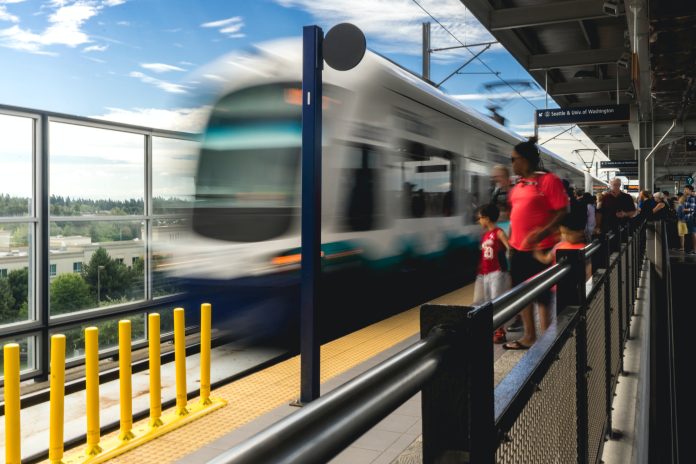
Our region’s employers see transportation as one of the most important things to get right for our community’s long-term health and success. Giving people more options to move around the region strengthens our economy, adds capacity as we grow, and opens access for all to good-paying jobs. Our regional light rail system is an integral piece of that puzzle – and it is more important than ever for Sound Transit to rise to the challenge ahead.
In March, Sound Transit reached a key milestone in our generational investment in transit. The Board of Directors identified the preferred station locations for the light rail extension from downtown Seattle to Ballard. The decision strikes the difficult balance of meeting the community’s interests while living within the fiscal constraints of the entire Sound Transit 3 (ST3) program, which will bring light rail not just to Seattle, but to Everett, Tacoma, and Issaquah. The agency will now complete the environmental review process and begin preliminary engineering.
This action follows the unanimous decision by the Board on the preferred station locations to West Seattle, which was a testament to the power of outreach and community agreement.
As we cross these planning milestones, it is equally critical that agency leadership sets the organization up to successfully execute.
The stakes couldn’t be higher: the $14.6 billion extensions of light rail to Ballard and West Seattle will be the largest capital project in the Puget Sound region since Interstate 5 was constructed in the 1960s. The $54 billion ST3 program is one of the largest capital programs in the U.S., and if Sound Transit doesn’t get the West Seattle and Ballard projects right, the extension of light rail to the rest of the region is at risk.
Sound Transit must follow recent recommendations to course-correct the agency’s delivery record, which come from a board-appointed technical advisory group made up of experts with experience delivering large capital programs. These recommendations come alongside the delay of light rail to Tacoma and ongoing challenges providing a safe and accessible experience for riders at downtown transit stations.
One important step the Board of Directors and agency leadership must take is to wholeheartedly endorse and swiftly implement the technical advisory group’s recommendations. Hard stop. No ifs, ands, or buts. If they do, the agency can deliver to voters what it promised in 2016. If they don’t, riders and voters will continue to read disappointing headlines about schedule delays and added costs and miss out on the opportunities of expanded transit.
What will resetting the agency’s capital delivery program look like? As a former staff member at Sound Transit, and someone who worked in the administration of two of the agency’s former board chairs, I have a point of view:
- Growing the team. In addition to the exceptional staff already at the agency – staff I have worked with and have confidence in – we need new leaders with knowledge and experience implementing multi-billion-dollar capital programs. The need for new talent isn’t an either/or, it is a both/and.
- Building trust. Trust between the Board of Directors and agency staff must be a top priority and should be built on communications that include a full and transparent accounting of the risks, costs, schedule, tradeoffs, impacts, opportunities, and community input.
- Continuously improving decision-making. Sound Transit should be relentless in streamlining and eliminating unnecessary steps that lead to additional costs and delays and – appropriately – empowering decision-making at the right level.
Only if the agency’s delivery program is reset can there be a real conversation about how the second transit tunnel in downtown Seattle will be constructed. I often say we need to embrace all the things that are true. It is true that we have to accept there will be real disruption with the construction of light rail. It is also true we will refuse to accept disruption that deeply undermines our efforts to revitalize downtown.
That is why the Chamber will continue to work hand-in-hand with Sound Transit, the City of Seattle, and our partners to address the outstanding issues around the Denny Station location in South Lake Union and develop a robust mitigation program that both avoids and mitigates impacts at the downtown stations.
Our region has never shied away from what others may see as impossible; on the contrary, we have embraced it. In 2016, the business community and the voters placed their trust in government to deliver a long overdue expansion of transit in our region. We can, and we will, get it right. And the Chamber will be there every step of the way.

Rachel Smith (Guest Contributor)
Rachel Smith is the president and CEO of the Seattle Metropolitan Chamber of Commerce, representing 2,500 businesses and about 750,000 employees. Rachel has played a pivotal role in delivering government investments that generate economic benefit and enhance quality of life for employers and their employees, including securing voter approval for transit proposals, authorization of investments in sporting venues and hospital infrastructure, helping businesses navigate the pandemic, and in 2022, securing passage of Move Ahead Washington, a state transportation package that included many business community priorities.

